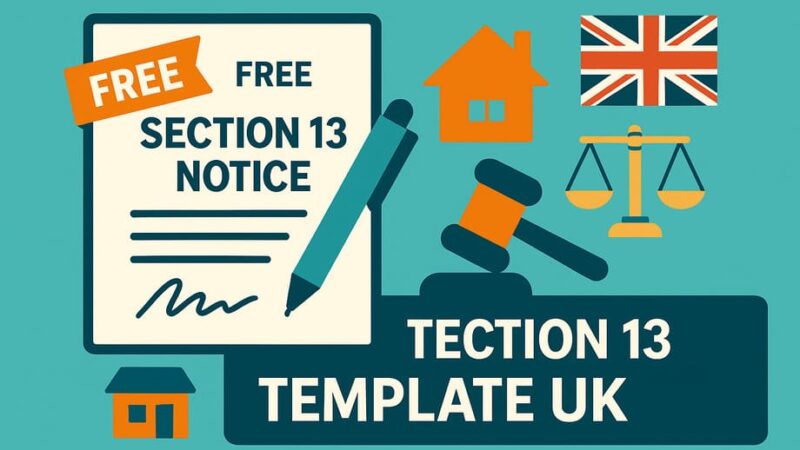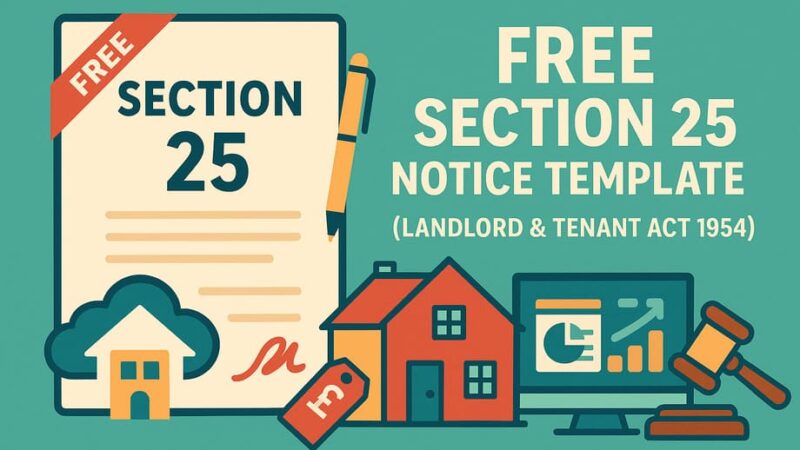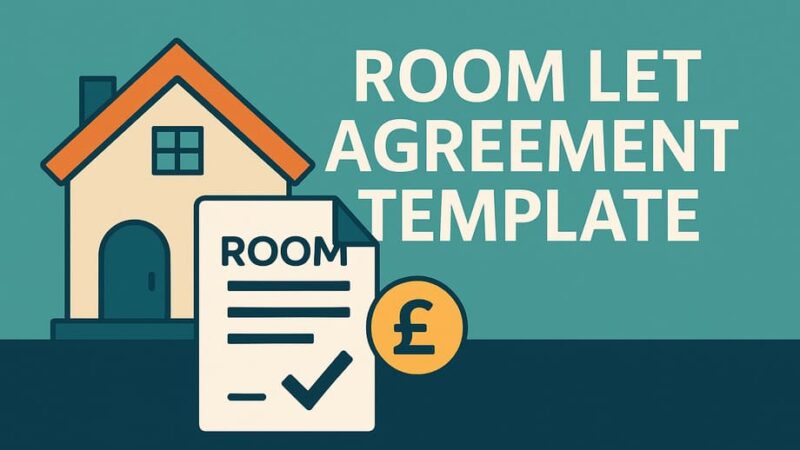Letter to Landlord About Damp and Mould [Free Template]
![Letter to Landlord About Damp and Mould [Free Template] 1 Letter to Landlord About Damp and Mould [Free Template]](https://www.yourpropertyblog.co.uk/wp-content/uploads/2025/08/letter-to-landlord-about-damp-and-mould-template.jpg)
Damp and mould in rental properties pose serious health risks and can make homes uninhabitable. If you’re dealing with these issues in your rental property, sending a formal written complaint to your landlord is essential for protecting your health and legal rights. A well-written letter creates documented evidence that you’ve reported the problem and gives your landlord clear notice to take action under their legal obligations.
UK tenants have strong legal rights when it comes to damp and mould issues. Landlords are legally required to maintain properties in habitable condition and address serious health hazards promptly. This guide provides a free template letter to help you report damp and mould problems professionally while ensuring you follow proper procedures for potential legal action if needed.
Written notice is crucial because it establishes a clear timeline of when you reported the problem and demonstrates that you’ve given your landlord reasonable opportunity to address the issue. This documentation becomes vital if you need to involve your local council’s environmental health department or pursue legal remedies for landlord negligence.
When Should You Write a Damp and Mould Letter?
Understanding when to send formal written complaints about damp and mould helps protect your health and establishes your legal rights if problems aren’t resolved promptly.
Health Risks and Immediate Concerns
Serious Health Impacts Damp and mould create significant health risks, particularly for vulnerable people including children, elderly residents, and those with respiratory conditions or compromised immune systems. Exposure can cause respiratory problems, allergic reactions, asthma attacks, and skin irritation.
The World Health Organization recognizes mould exposure as a serious health hazard that can trigger both immediate and long-term health problems. If you or your family members are experiencing health symptoms that might be related to damp or mould, send a complaint letter immediately and seek medical advice.
When Problems Affect Daily Life Send a formal letter when damp or mould issues significantly impact your ability to use and enjoy your home. This includes situations where rooms become unusable due to persistent damp, mould growth makes areas unhygienic, strong musty odors pervade living spaces, or condensation problems create ongoing discomfort.
Landlord Legal Responsibilities
Housing Health and Safety Rating System (HHSRS) Under UK housing law, landlords must ensure rental properties meet health and safety standards. Damp and mould are classified as Category 1 hazards under the Housing Health and Safety Rating System, meaning landlords have immediate obligations to address these problems when they arise.
Local authorities can take enforcement action against landlords who fail to address Category 1 hazards, including serving improvement notices and potentially prosecuting serious cases of negligence.
Fitness for Human Habitation The Homes (Fitness for Human Habitation) Act 2018 requires rental properties to be fit for human habitation throughout tenancies. Persistent damp and mould problems can make properties legally uninhabitable, giving tenants grounds for rent reduction or early tenancy termination.
Landlord Repair Obligations Under the Landlord and Tenant Act 1985, landlords must maintain the structure and exterior of properties, including addressing damp problems caused by structural defects, roof leaks, or inadequate ventilation systems.
UK Housing Act Requirements
Section 11 Obligations Section 11 of the Landlord and Tenant Act 1985 specifically requires landlords to keep properties in repair and proper working order. This includes addressing underlying causes of damp such as faulty guttering, roof damage, or inadequate heating systems.
Immediate Response Requirements For serious health hazards like extensive mould growth, landlords should respond within 24-48 hours and begin remedial action immediately. Less urgent damp issues still require prompt attention, typically within 2-4 weeks depending on severity.
How to Write a Damp and Mould Complaint Letter
Creating an effective complaint letter requires specific information and clear documentation that helps your landlord understand the severity of the problem and their legal obligations to address it.
Describe the Problem Clearly
Specific Location Details Identify exactly where damp and mould problems are occurring, including specific rooms, walls, ceilings, or areas affected. Describe the extent of coverage – whether it’s small patches or extensive areas – and note any patterns like recurring damp after rain or mould growth in specific locations.
Include details about the type of damp you’re experiencing: rising damp from ground level, penetrating damp through walls or roofs, or condensation damp from poor ventilation. This information helps landlords and contractors identify appropriate solutions.
Visual Description Describe what you can see: black, green, or white mould growth; water stains or discoloration on walls or ceilings; peeling wallpaper or paint; visible condensation on windows or walls; or musty, damp odors throughout affected areas.
Note any progression you’ve observed – whether problems are getting worse, spreading to new areas, or recurring despite temporary cleaning efforts.
Include Dates and Photos
Detailed Timeline Document when you first noticed the damp or mould problems and how they’ve developed over time. Include specific dates when problems began, worsened, or spread to new areas, and note any seasonal patterns or connections to weather conditions.
Record any temporary measures you’ve taken to address the problem, such as increased ventilation, dehumidifier use, or cleaning mould growth, and note whether these measures provided any improvement.
Photographic Evidence Take clear, well-lit photographs that show the extent of damp and mould problems from multiple angles. Include close-up shots that clearly show mould growth and wider shots that demonstrate the scope of affected areas.
Date-stamp photographs or include newspaper headlines or phone screenshots showing dates to establish when problems existed. Take new photos regularly to document progression if problems worsen.
Request a Timeline for Repairs
Specific Action Requests Request specific actions from your landlord including professional inspection to identify underlying causes, immediate mould cleaning and treatment, repairs to address structural causes of damp, and improvements to ventilation or heating systems if needed.
Ask for a clear timeline showing when inspection will occur, when remedial work will begin, and when problems will be fully resolved. For serious health hazards, request immediate action within 24-48 hours.
Professional Standards Request that any work is carried out by qualified professionals with appropriate expertise in damp and mould remediation. Specify that you want assurance that underlying causes will be addressed, not just surface symptoms treated.
Keep a Copy for Your Records
Documentation Importance Maintain copies of all correspondence with your landlord, including your initial complaint letter, any responses received, and follow-up communications. This documentation proves you’ve properly notified your landlord and given them opportunity to address problems.
Keep detailed records of any health impacts you or your family experience that might be related to damp and mould exposure, including dates, symptoms, and any medical advice or treatment sought.
Evidence Organization Organize your evidence systematically with dated photographs, correspondence files, and incident logs that can be easily provided to local authority officers, legal advisors, or healthcare professionals if needed.
Free Damp and Mould Letter Template
Here’s a professional template you can customize for your specific situation:
Damp and Mould Complaint Letter Template
[Your Name]
[Your Address]
[City, Postal Code]
[Your Phone Number]
[Your Email Address]
[Date]
[Landlord's Name]
[Landlord's Address]
[City, Postal Code]
Dear [Landlord's Name],
Re: URGENT REPAIR REQUEST - Damp and Mould at [Property Address]
I am writing to formally report serious damp and mould problems at the above
property, which I rent under a tenancy agreement dated [tenancy start date].
DESCRIPTION OF PROBLEM:
I have discovered significant damp and mould issues affecting the following
areas of the property:
• Location: [Specific rooms and areas affected]
• Type of damp: [Rising damp/Penetrating damp/Condensation/Unknown]
• Mould growth: [Color, extent, and specific locations]
• Other issues: [Water stains, peeling paint, musty odors, etc.]
DETAILED OBSERVATIONS:
[Provide specific details about what you can see:]
• Black mould covering approximately [size] area on [location]
• Persistent damp patches on [walls/ceiling] measuring [dimensions]
• Strong musty odors throughout [affected rooms]
• Condensation problems on [windows/walls]
• [Any other specific observations]
TIMELINE OF PROBLEM:
• First noticed: [Date when problem first observed]
• Problem development: [How it has worsened or spread]
• Current status: [Describe current severity]
• Weather connections: [Any patterns related to rain/weather]
HEALTH AND SAFETY CONCERNS:
This damp and mould is causing serious health and safety concerns:
• Health symptoms: [Any symptoms experienced by household members]
• Impact on daily life: [How it affects use of affected rooms]
• Vulnerable occupants: [Children, elderly, or those with health conditions]
• Property damage: [Damage to belongings or fixtures]
PHOTOGRAPHIC EVIDENCE:
I have taken photographs documenting the extent of the damp and mould
problems and can provide these immediately upon request.
LEGAL OBLIGATIONS:
Under the Landlord and Tenant Act 1985 and the Housing Health and Safety
Rating System, you are legally required to:
• Maintain the property in good repair
• Address Category 1 hazards including damp and mould
• Ensure the property remains fit for human habitation
The Homes (Fitness for Human Habitation) Act 2018 requires rental
properties to be free from serious health hazards throughout tenancies.
IMMEDIATE ACTION REQUIRED:
I request that you arrange the following actions immediately:
1. URGENT INSPECTION: Professional inspection within 48 hours to assess
the extent of damp and mould problems and identify underlying causes.
2. IMMEDIATE SAFETY MEASURES: Any necessary immediate action to protect
health and safety, including professional mould treatment if extensive
growth is present.
3. REMEDIAL REPAIRS: Comprehensive repairs to address underlying causes
of damp, including any necessary work to:
- Roof or guttering systems
- External walls or pointing
- Ventilation systems
- Heating systems
- Structural defects
4. PROFESSIONAL CLEANING: Professional mould remediation and cleaning
of all affected areas once underlying causes are addressed.
5. PREVENTION MEASURES: Installation of adequate ventilation, heating,
or other systems to prevent future damp and mould problems.
TIMELINE REQUEST:
Please provide me with a clear timeline showing:
• When professional inspection will occur
• When remedial work will begin
• When all work will be completed
• Any temporary measures needed while work is ongoing
ACCESS ARRANGEMENTS:
I am available to provide access for inspection and repairs during:
[State your availability - e.g., weekdays 9 AM-5 PM, weekends by arrangement]
Please contact me on [phone number] or [email address] at least 24 hours
before any visits to confirm timing.
URGENT RESPONSE REQUIRED:
Given the serious health risks associated with damp and mould, I expect
your immediate attention to this matter. Please confirm receipt of this
letter and your action plan within 48 hours.
If I do not receive a satisfactory response within 48 hours, or if
adequate action is not taken promptly, I will have no choice but to:
• Contact the local authority environmental health department
• Seek advice about rent reduction or early tenancy termination
• Consider legal action for breach of statutory obligations
• Report health impacts to appropriate medical professionals
COOPERATION EXPECTED:
I look forward to your immediate response and prompt action to resolve
these serious health and safety issues. I am willing to cooperate fully
with any necessary inspection and repair work.
Thank you for your urgent attention to this matter.
Yours sincerely,
[Your Signature]
[Your Printed Name]
[Date]
ATTACHMENTS:
☐ Photographs of damp and mould problems
☐ Medical records if health impacts experienced
☐ Previous correspondence about this issue (if any)
COPIES SENT TO:
☐ Local Authority Environmental Health Department
☐ Citizens Advice
☐ [Other relevant parties]
[DOWNLOAD WORD TEMPLATE] | [DOWNLOAD PDF TEMPLATE]
Example Letter to Landlord
Here’s a realistic example of how the template might look when completed:
Completed Example Letter
Sarah Johnson
Flat 2B, 15 Oak Street
Manchester, M14 6HY
07789 123456
sarah.johnson@email.com
15th March 2025
Mr. David Wilson
Wilson Property Management
42 High Street
Manchester, M1 3AB
Dear Mr. Wilson,
Re: URGENT REPAIR REQUEST - Damp and Mould at Flat 2B, 15 Oak Street, Manchester
I am writing to formally report serious damp and mould problems at the above
property, which I rent under a tenancy agreement dated 1st September 2024.
DESCRIPTION OF PROBLEM:
I have discovered significant damp and mould issues affecting the following
areas of the property:
• Location: Main bedroom, bathroom, and living room
• Type of damp: Appears to be penetrating damp and condensation issues
• Mould growth: Black mould on walls and ceiling, green mould around windows
• Other issues: Strong musty smell, peeling wallpaper, water stains on ceiling
DETAILED OBSERVATIONS:
• Black mould covering approximately 2 square meters on bedroom wall adjacent
to bathroom
• Persistent damp patches on living room ceiling measuring 1.5m x 1m
• Strong musty odors throughout bedroom and bathroom
• Daily condensation on all windows despite regular ventilation
• Green mould growth around bathroom window frame
• Wallpaper peeling in bedroom corner where damp is worst
TIMELINE OF PROBLEM:
• First noticed: 15th January 2025 (small patch in bedroom)
• Problem development: Steadily worsened and spread to new areas
• Current status: Now affecting three rooms with extensive mould growth
• Weather connections: Problems significantly worse after heavy rain periods
HEALTH AND SAFETY CONCERNS:
This damp and mould is causing serious health and safety concerns:
• Health symptoms: I've developed persistent cough and my asthma has worsened
• Impact on daily life: Unable to use bedroom properly due to smell and health concerns
• Vulnerable occupants: I suffer from asthma which is being aggravated
• Property damage: My clothes and bedding are developing mould spots
PHOTOGRAPHIC EVIDENCE:
I have taken photographs documenting the extent of the damp and mould
problems and can provide these immediately upon request.
LEGAL OBLIGATIONS:
Under the Landlord and Tenant Act 1985 and the Housing Health and Safety
Rating System, you are legally required to:
• Maintain the property in good repair
• Address Category 1 hazards including damp and mould
• Ensure the property remains fit for human habitation
IMMEDIATE ACTION REQUIRED:
I request that you arrange the following actions immediately:
1. URGENT INSPECTION: Professional inspection within 48 hours to assess
the extent of damp and mould problems and identify underlying causes.
2. IMMEDIATE SAFETY MEASURES: Professional mould treatment in bedroom
and bathroom areas where growth is extensive.
3. REMEDIAL REPAIRS: Investigation and repair of suspected roof leak
causing living room ceiling damp, and improvement of bathroom
ventilation system.
4. PROFESSIONAL CLEANING: Professional mould remediation and redecorating
of affected areas once underlying causes are addressed.
TIMELINE REQUEST:
Please provide me with a clear timeline for all necessary work.
ACCESS ARRANGEMENTS:
I am available to provide access Monday-Friday 9 AM-5 PM, and weekends
by arrangement. Please contact me on 07789 123456 or sarah.johnson@email.com
at least 24 hours before any visits.
URGENT RESPONSE REQUIRED:
Given the serious health risks and my worsening asthma symptoms, I expect
your immediate attention to this matter. Please confirm receipt of this
letter and your action plan within 48 hours.
If I do not receive a satisfactory response, I will contact Manchester
City Council's environmental health department for assistance.
Thank you for your urgent attention to this matter.
Yours sincerely,
Sarah Johnson
15th March 2025
What to Do if Your Landlord Ignores the Letter
When landlords fail to respond to damp and mould complaints or don’t take adequate action, you have several escalation options to protect your health and legal rights.
Contact Council Environmental Health
Local Authority Powers Your local council’s environmental health department has statutory powers to investigate damp and mould complaints and can force landlords to take action. They can inspect properties, serve improvement notices, and prosecute landlords who fail to address serious health hazards.
Environmental health officers understand the health risks associated with damp and mould and can provide objective assessment of whether problems constitute statutory nuisance or health hazards that require immediate action.
How to Contact Environmental Health Contact your local council’s environmental health department by phone or online reporting system. Provide copies of your complaint letter to your landlord, photographic evidence of problems, and details about any health impacts you’re experiencing.
Most councils respond to serious health hazard reports within 5-10 working days and may conduct property inspections to assess the severity of problems.
What Environmental Health Can Do Council officers can serve improvement notices requiring specific repairs within set timeframes, arrange emergency repairs at landlord expense if immediate health risks exist, and prosecute landlords who fail to comply with legal notices.
They can also provide independent verification of health hazards that supports any legal action you might consider taking against your landlord.
Possible Legal Action
Rent Reduction Claims Persistent damp and mould problems that significantly affect your ability to use and enjoy the property may entitle you to rent reduction through first-tier property tribunals. Document how problems impact your daily life and any additional costs incurred.
Early Tenancy Termination Serious damp and mould issues that make properties uninhabitable may give you grounds to terminate tenancies early without penalty. Seek legal advice before taking this step to ensure you follow proper procedures.
Compensation Claims You may be entitled to compensation for damaged belongings, additional heating or dehumidifier costs, alternative accommodation expenses, and health impacts caused by landlord negligence in addressing damp and mould.
Personal Injury Claims If damp and mould exposure causes significant health problems, you may have grounds for personal injury claims against your landlord. Keep detailed medical records and seek professional legal advice for these complex cases.
Emergency Temporary Measures
Immediate Health Protection While pursuing formal resolution, take steps to protect your health including using dehumidifiers to reduce moisture levels, ensuring maximum ventilation when weather permits, and temporarily relocating from severely affected rooms if possible.
Seek medical advice if you experience persistent respiratory symptoms, allergic reactions, or other health problems that might be related to mould exposure.
Document Additional Costs Keep receipts for any expenses you incur due to damp and mould problems, including dehumidifiers, additional heating costs, replacement of damaged belongings, and alternative accommodation costs.
These costs may be recoverable from your landlord through legal action or insurance claims.
FAQ Section
Do I need to send this by post?
While email is acceptable for initial complaints, sending formal letters by recorded delivery provides stronger evidence that your landlord received notice of the problem. This proof becomes important if disputes escalate to legal proceedings or council involvement.
For urgent health hazards, send the letter by email immediately and follow up with posted copies to ensure the fastest possible communication while maintaining proper documentation.
Can I email my landlord about damp?
Yes, email is an acceptable method for reporting damp and mould issues to your landlord. However, ensure you keep copies of all emails and request read receipts where possible to prove your landlord received your complaint.
Follow up important emails with phone calls to confirm receipt and discuss urgent action needed for health and safety concerns.
What if mould affects my health?
If you experience health symptoms that might be related to mould exposure, seek medical advice immediately and document any symptoms, treatments, or medical advice received. Include health impacts in your complaint letter and emphasize the urgency of remedial action.
Consider requesting temporary alternative accommodation if health symptoms are severe and the property remains uninhabitable due to mould problems.
How long should I wait for a response?
For serious health hazards like extensive mould growth, expect responses within 24-48 hours and beginning of remedial action within a few days. For less urgent damp issues, 7-14 days is reasonable for initial response and action plan.
If you don’t receive adequate response within these timeframes, escalate immediately to your local council’s environmental health department.
Can I withhold rent for damp and mould?
Generally, you cannot simply stop paying rent due to damp and mould issues. However, you may be entitled to rent reduction through formal tribunal proceedings if problems significantly affect your ability to use the property.
Seek legal advice before withholding rent, as this could put you at risk of eviction proceedings even if you have legitimate complaints about property condition.
What if my landlord says it’s my fault?
Landlords sometimes blame tenants for condensation problems, claiming insufficient ventilation or heating use. However, landlords remain responsible for ensuring properties have adequate ventilation and heating systems to prevent condensation and mould growth.
If your landlord claims tenant responsibility, request professional assessment to determine whether problems result from structural defects or inadequate building systems rather than tenant behavior.
Download Your Free Template
Get your professional damp and mould complaint letter template:
- Customizable letter template for formal complaints
- Example completed letter showing realistic usage
- Guidance notes for effective complaint writing
- Evidence checklist for supporting documentation
Available formats:
- PDF: Print and complete by hand
- Word: Editable for multiple situations
- Email template: Digital communication version
[DOWNLOAD WORD TEMPLATE] | [DOWNLOAD PDF TEMPLATE] | [EVIDENCE CHECKLIST]
Legal Disclaimer: This template provides guidance only and should not be considered legal advice. Damp and mould issues involve complex health, safety, and legal considerations that vary by situation. Consider professional legal advice for serious health impacts or when landlords fail to respond adequately to legitimate complaints. Always ensure compliance with current housing and health legislation.
Dealing with damp and mould in your rental property? Download our free letter template and protect your health while ensuring your landlord meets their legal obligations under UK housing law.
Last Updated on August 24, 2025 by James Cartwright







![Letter to Tenant for Late Rent Payment [Free Template] 7 Letter to Tenant for Late Rent Payment [Free Template]](https://www.yourpropertyblog.co.uk/wp-content/uploads/2025/08/letter-to-tenant-for-late-rent-payment-template-800x450.jpg)